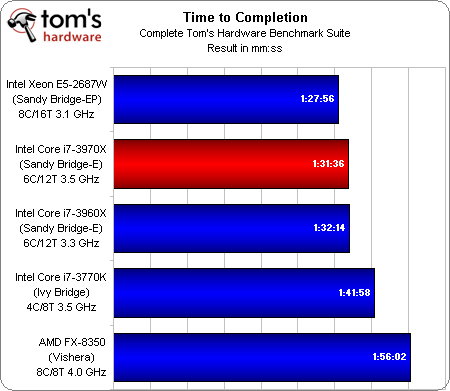Core i7-3970X Extreme Review: Can It Stomp An Eight-Core Xeon?
After one year of dominating the enthusiast space, Intel's Core i7-3960X is being replaced. The new Core i7-3970X features higher clock rates, but also imposes a 150 W TDP. Just for kicks, we're putting it up against another 150 W CPU: the Xeon E5-2687W.
Power Consumption And Efficiency
Logging power consumption during the entire benchmark run gives us a window into the behavior of each processor and platform.
We’ll start by looking at the Core i7-3970X’s green line. A 150 W TDP should have been enough for us to know that high power consumption would be measurable. Indeed, the -3970X spikes up to use the most power under load.
What about the eight-core Xeon E5, which is also a 150 W processor? Despite that rating, its consumption is far below the new Core i7s, and in fact looks to be even more conservative than FX-8350’s power use.
Although the Core i7-3960X is only just slightly slower than the -3970X, the yellow line is quite a bit lower on our chart. And of course, the Core i7-3770K is downright miserly.
Averaging those power numbers out reveals that Intel’s Core i7-3970X fares worst. And although the Xeon E5 bears the same 150 W rating, it ends up using even less power than the 130 W Core i7-3960X.
Calculating efficiency requires that we know two things, though. First, we need the consumption figures above. Then, we need some measure of performance.
We capture this data by logging our scripted benchmark suite in two-second intervals. Multiplying out the number of resulting samples by two, dividing by 60 (minutes), and dividing by 60 again (hours) tells us how long each processor takes to wrap up testing.
Get Tom's Hardware's best news and in-depth reviews, straight to your inbox.
Eight cores reign, it appears, though the Core i7-3970X and -3960X aren’t far behind. Opting for a Core i7-3770K gets you significantly lower average power use; however, it also takes 10 minutes longer than the -3970X to complete testing.
We’ll leave the FX-8350 alone in all of this. Its high power consumption and last-place performance are countered only by a $220 price tag.
Not surprisingly, Intel’s 77 W Core i7-3770K is the most efficient choice. More interesting is the fact that the 150 W Xeon combines brutal speed with lower-than-expected consumption to finish second in our efficiency metric.
Core i7-3970X isn’t able to add enough performance to make up for dramatically higher power use, and this reflects in its loss to the -3960X.
Then there’s the FX-8350, which, again, combines modest performance and high average power use, hurting its efficiency story.
Current page: Power Consumption And Efficiency
Prev Page Benchmark Results: World of Warcraft: Mists Of Pandaria Next Page Core i7-3970X: Faster, But Less Efficient At The Same Price-
amuffin 100mhz faster than the 3960X, not worth the extra premium.Reply
Same thing goes for the 3960X compared to the 3930K....not worth the extra 100mhz for $400.... -
tumetsu I've recently started facepalming every time I see BF3 in CPU benchmarks. "Boy oh boy, this hasn't been confirmed like a hundred times already but the single player is decidedly graphics-bound, so here, have these charts with identical results anyway."Reply -
dragonsqrrl jaquithBoo on Intel for not enabling all 8-cores especially at that price!They don't have much of a choice when it comes to the i7's. With the 32nm Sandy Bridge-E Intel has to make a choice between prioritizing clocks or core count within a 150W TDP, based on the target workload for a particular processor. For Xeon's the choice is easy, more cores. For desktop applications the choice isn't as clear, but I think most users would still benefit more from a higher clocked 6-core than a lower claocked 8-core. That's slowly changing though.Reply
Intel also doesn't want a situation where their LGA 1155 processors outperform their $1000 extreme edition in lightly threaded workloads, which is yet another reason to favor 6-core for now.
I'd personally like to see an 8-core i7, even if it means lower clocks, but I don't think that'll happen until Ivy Bridge-E. At 22nm Intel probably won't have to make a choice, we'll get the best of both worlds. -
nebun jaquithBoo on Intel for not enabling all 8-cores especially at that price!why would they....they don't need to do it at this time....amd's top cpu is still very slow when compared with even intels mid rannge cpusReply -
unknown9122 Why do people still benchmark on itunes 10.4? 10.7 is out... as for the 8 cores as said above^, there is no need to have more than 6. Because if it had 8, then xeons would not sell to pros.Reply -
BoredErica Why are we not manually overclocking this expensive CPU? Why do we do benchmarks against stock ig 2500k?Reply -
A Bad Day You also forgot something when comparing against Xeon:Reply
Stability test.
Run the i7 for one month under Prime95. It will crash. Run the Xeon for one month under Prime95. If it crashes, then you got a defective Xeon because they're not suppose to crash under 24/7 workload. -
anthonyorr nebunwhy would they....they don't need to do it at this time....amd's top cpu is still very slow when compared with even intels mid rannge cpusReply
Why would you even include the 8350? It is 1/6th the price of this CPU. I couldn't imagine what a modern AMD desktop CPU would consist of at the $1000+ price range.




